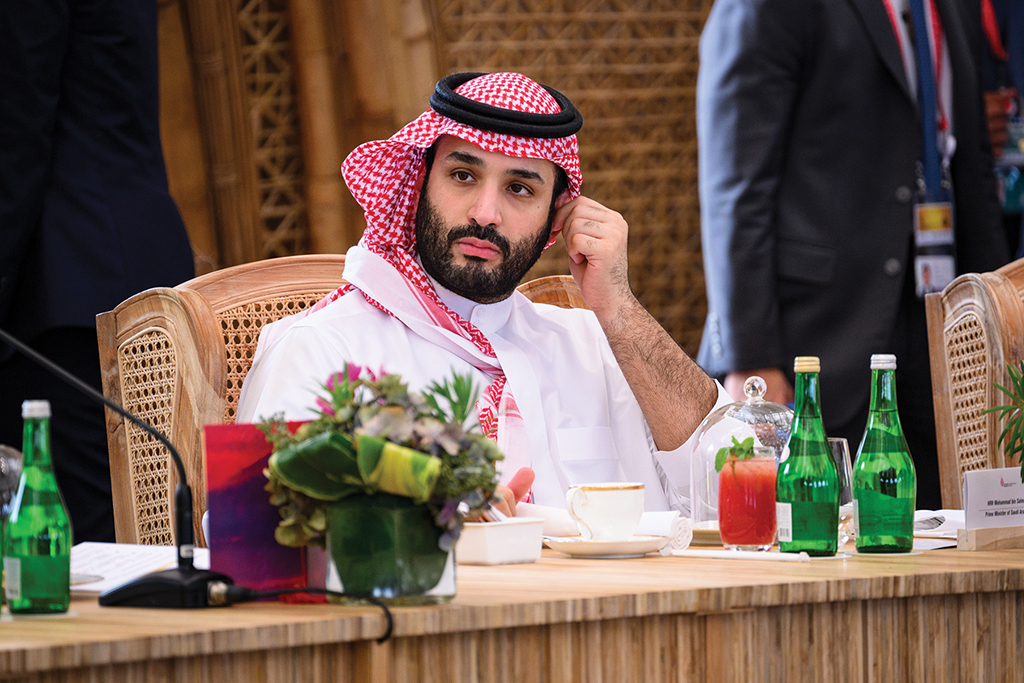
New Murabba, a planned modern downtown in Riyadh, will include the Mukaab, a large cube structure housing retail, cultural and tourism attractions.
With 70% of its 34 million population under 30 years old and well accustomed to flying domestically and internationally, Saudi Arabia is regarded as the Middle East region’s sleeping giant.
Domestic passenger numbers are climbing rapidly, and the increase is likely to be duplicated on the international front as the country opens its doors to foreign leisure travelers.
Until now, Saudi Arabia’s airline sector has been held back by factors that include the country’s austere reputation, the virtual impossibility of obtaining visas for anything other than business or religious visits, and the low visibility of national carrier Saudia among foreign travelers.
A lack of connecting flights through the country’s main hubs of Riyadh, Jeddah and Dammam has also hindered the country’s emergence as a major international transit point.
Those factors are changing. Under the country’s Vision 2030 project designed to diversify the economy away from oil, tourism is planned to become a major sector. At a cost of $500 billion, the Neom Red Sea Project will see a series of huge resorts, industrial complexes and airports being built on the country’s northwest coast; advertisements for Saudi Arabia’s historic sites are starting to appear in European media, and tourism visas have become available on entry for citizens of 49 nations.
Another ambitious Vision 2030 undertaking is the New Murabba project in Riyadh—a modern downtown that will include more than 100,000 residential units, 9,000 hotel rooms, and numerous entertainment and cultural venues. The project will feature a 400-m tall cube structure—the Mukaab—enclosing a spiral tower. The Mukaab will use digital and virtual technologies to create “the world’s first immersive destination,” according to the country’s sovereign wealth organization, the Public Investment Fund (PIF), and will include retail and tourist attractions.
New Flag Carrier
Much of the country’s aviation future is tied up with the planned new flag carrier, which was formally announced in mid-March by Crown Prince Mohammed bin Salman after a long silence about the project.

The airline will be named Riyadh Air, he said, and will be a wholly owned subsidiary of PIF.
Another long-held open secret was also confirmed. Former Etihad Airways Group CEO Tony Douglas, who left the Abu Dhabi airline last fall, has been appointed Riyadh Air CEO.
The airline’s senior management will include Saudi and international expertise, the crown prince added. Riyadh Air will be chaired by PIF governor Yasir Al-Rumayyan.
The March 12 announcement said Riyadh Air plans to serve 100 destinations by 2030, but otherwise offered no details about timescales for establishing the new carrier or about its equipment.
But the scale of expectations within the Saudi government are believed to be sizeable; the crown prince is said to want the new carrier to be the size of Emirates Airline within seven years of launch.
And, according to OAG Traffic Analyser, the government is targeting 330 million passengers traveling to and from Saudi Arabia by 2030. Passenger volumes reached 87 million immediately pre-pandemic and just 50 million last year.
The rationale behind Riyadh Air also remains unclear, although it appears that Saudi Arabia wants to set up the same type of super-connector hubs that exist in Dubai and Qatar. This is despite the fact that transit traffic brings lower yields than O&D services and that Riyadh Air will find itself in immediate competition with Emirates and Qatar Airways, which are unlikely simply to accept the loss of market share to the upstart. That suggests a possible price war between the parties.
Certainly, Saudi Arabia has extremely deep pockets, with suggestions that $30 billion has been earmarked to get Riyadh Air up and running.
Historic Aircraft Orders
And two days after formally announcing Riyadh Air, the scale and scope of Vision 2030 became more apparent with the announcement of orders for up to 121 Boeing 787s for Riyadh Air and Saudia. Combined, this amounts to the fifth-largest commercial order by value in Boeing’s history. The aircraft will be powered by GE Aerospace GEnx engines.
Saudia said it would grow its long-haul fleet with up to 49 787s—purchasing 39 with a further 10 options. The agreement will include both 787-9s and 787-10s.
Riyadh Air said it would purchase 39 787-9s, the longest-range 787, with options for an additional 33.
Saudia already operates more than 50 Boeing aircraft on its long-haul network, including 777-300ERs, 787-9s and 787-10s.
“Saudia continues its expansion efforts in all aspects of the airline; whether it’s introducing new destinations or increasing the aircraft fleet,” Saudia Group director general Ibrahim Al-Omar said. “The agreement with Boeing delivers on this commitment and the newly added aircraft will further enable Saudia to fulfill its strategic objective of bringing the world to the kingdom.”
Riyadh Air’s Douglas, meanwhile, commented, “The new airline reflects the ambitious vision of Saudi Arabia to be at the core of shaping the future of global air travel and be a true disrupter in terms of customer experience.
“By positioning the airline as both a global connector and a vehicle to drive tourist and business travel to Saudi Arabia, our new 787-9 airplanes will serve as a foundation for our worldwide operations, as we build the wider network and connect our guests to Saudi Arabia and many destinations around the world.”
CAA Agreement
Other countries are noticing the Saudi government’s commercial aviation push and stepping up cooperative activity. For example, the UK and Saudi Arabia signed an agreement early this year to assess and enhance the Arabian nation’s safety regulatory framework.
The agreement is between the Saudi regulator, the General Authority of Civil Aviation (GACA), and CAA International (CAAi), the technical cooperation, consulting and aviation training arm of the UK’s Civil Aviation Authority (CAA).
The agreement is in the form of a regulator-to-regulator partnership to ensure Saudi Arabia’s aviation safety standards are in line with global best practices.
The move should be seen in the context of the Vision 2030 initiative, as GACA is leading the implementation of the Saudi Aviation Strategy. GACA has launched an Aviation Standards Optimization program to apply world-leading aviation safety standards and enhance passenger experience. CAAi and GACA intend to support the program by examining global best-practice regulatory frameworks for aviation safety and making recommendations to enhance the state’s safety program and its national aviation safety plan.
“GACA is committed to delivering world-class regulations that improve passenger safety and the passenger experience,” GACA president Abdulaziz bin Abdullah Al-Duailej said. “This project is an example of how we are transforming our regulations to enable growth in line with the Saudi Aviation Strategy, and in support of Vision 2030.”
The agreement builds on an MOU signed in 2018 between the CAA and GACA on civil aviation technical cooperation and subsequent projects on Economic Regulation and Air Navigation Service Oversight.
“There is no doubt that Saudi Arabia has become a globally influential player in civil aviation, with new airlines, airports and infrastructure well underway since the launch of Vision 2030 and the Saudi Aviation Strategy,” CAAi managing director Maria Rueda commented.
“As the country looks to 2030 and beyond, we stand committed to working with Saudi Arabia to enhance its legislative and regulatory framework to further support its air transport sector’s long-term, sustainable growth.”
Saudia’s Future
With all this activity, one major outstanding question remains: If Riyadh Air is to be the new international face of Saudi Arabia, what will Saudia’s future look like?
As recently as 2019, Saudia seemed on the brink of a major expansion, with large orders for new aircraft placed at that year’s Paris Air Show. And company officials were openly talking of dramatically raising the airline’s profile in international markets. However, problems remained. Saudia at that time had huge overstaffing problems with a fleet of around 180 aircraft, but 18,000 personnel.
“There was a big disconnect between the hardware and the software, i.e., the people,” a senior airline executive in the region told ATW. “People just weren’t hungry for success.” And, being a state-run enterprise, it was almost impossible to get rid of surplus staff.
Today, there is a contrast between those members of the wider 11-company-strong Saudia Group that have been privatized, such as the cargo and catering businesses, and those that remain under state control, he added. “You have very, very capable Saudi business people” running the privatized entities that have adopted Western ways of doing business.
Saudi investors put their own money into the businesses, appointed expatriate managers and the companies are doing well. The catering operation, for example, is winning third-party contracts. “They have a fantastic future in front of them,” the executive said.
External consultants have been brought into Saudia to improve the skills of cabin crew, ground staff and maintenance personnel.
“Saudia invested in the product,” an airline executive familiar with the country told ATW. “Today, Saudia, I would say, is not at a comparable level to Qatar, Emirates or Turkish, but it has moved a huge step in the right direction. Now, what Saudia needs to do is get more aggressive in marketing and let people know they have a state-of-the-art operation.”
But that improvement may be overtaken by events.
“They have been very tight-lipped about the new airline,” noted the second executive. “But from what they’ve said and what I understand is that the division of traffic will see Saudia focusing on religious traffic, while the new airline in Riyadh will be the for business and transfer traffic and growing Riyadh into having a much more prominent position in the Middle East.” The holy Islamic cities of Mecca and Medina are close to Saudia’s Jeddah headquarters.
He accepted that transit passengers give lower yields than O&D traffic, “but it’s a good way to fill your empty seats and get your basic loads. You have to be careful with modern yield management systems to get the right mix of O&D and connecting traffic, but the ambition of the crown prince to grow traffic tenfold means that the only way to do this is to get access to transfer traffic.”
He added there would “absolutely” be enough traffic for both Saudia and Riyadh Air, especially when business and tourism flows begin to ramp up. And with the Saudi government planning to increase the number of Muslims making the Hajj and Umrah pilgrimages from 10 million in 2019 to 30 million by 2030, finding enough passengers seems an attainable goal.
This is especially so because the Saudi government stipulates that 50% of all pilgrim flights should be operated by Saudi carriers, which means that it is effectively a captive market.
“You don’t have to sell seats, you just take orders for them,” said one airline official. “And you don’t have to deal with sophisticated yield management systems; you can charge whatever amount you want.”
Airport Investments
Meanwhile, existing airports in Saudi Arabia are being significantly upgraded. The most prominent is the plan for the new King Salman International Airport in the capital, Riyadh. This will see a huge new terminal being built for the six-runway project that will incorporate and eventually supersede the facilities of the city’s current King Khalid International Airport. Annual passenger capacity is planned to rise to 120 million by the end of this decade and 185 million by 2050.

Jeddah’s King Abdulaziz International Airport, Saudia’s home hub, has also been hugely improved in recent years. In August 2022 Airports Council International noted that the new Terminal 1, which opened in 2019, will allow it to handle 45 million passengers per year by 2030. Expansion plans could push this to 114 million passengers annually after 2035.
The kingdom’s third major airport, King Fahd International in Dammam, on the east coast, is also scheduled to increase its terminal capacity from the current 12.5 million to 30 million by 2025.
Smaller airports are also being constructed. A completely new facility sprang out of the desert in only eight months to serve the Neom project. Initial passenger infrastructure at the new airport was “not fantastic,” admitted one senior western executive who lives in the country, but the airport is serving its initial purpose, namely allowing the personnel who are building the tourism resorts and a futuristic skyscraper city called The Line—170 km long but just 200 m wide—to be ferried in and out of the area.
Another airport in the area, Red Sea International, is planned to open its doors by the end of this year, acting as a gateway for the first of the region’s tourist resorts.

